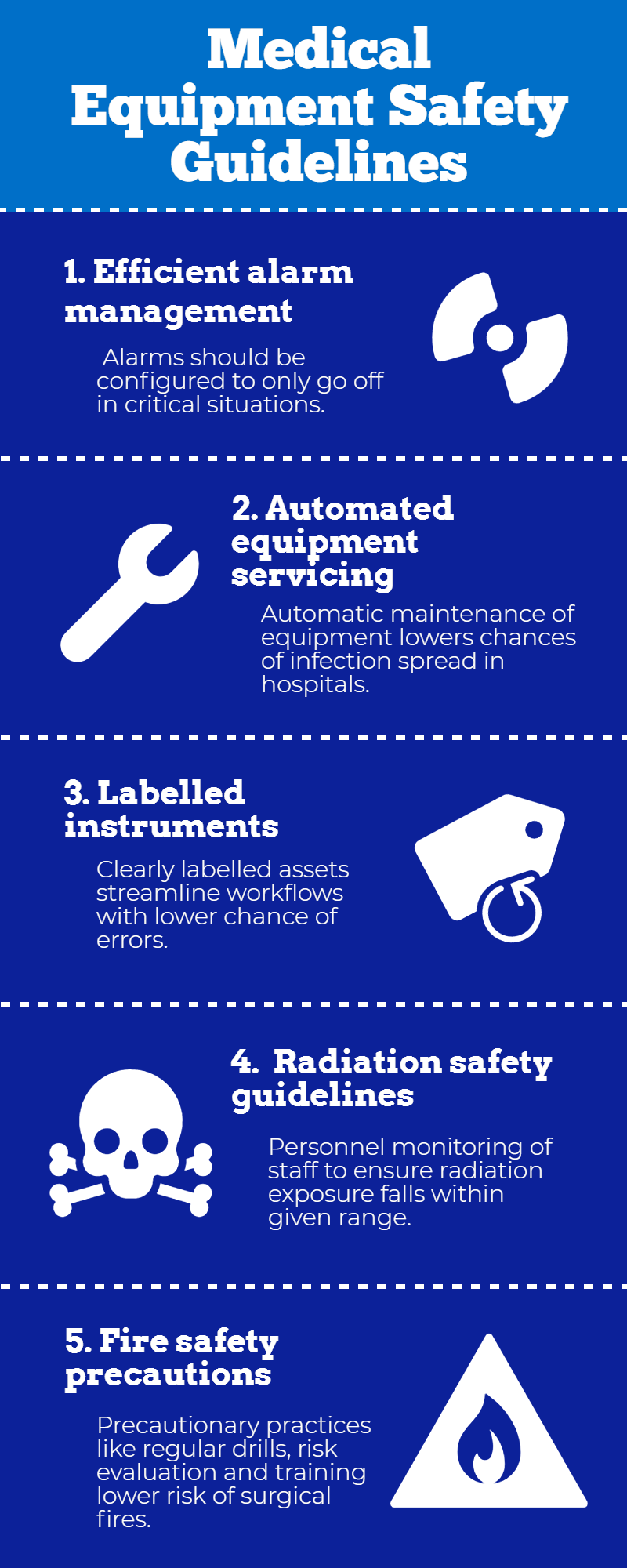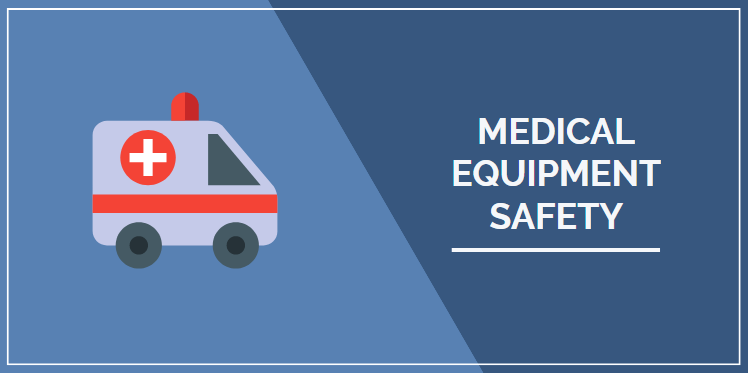Medical equipment classification
Surgical tools and machinery aid medical procedures and are critical to the diagnosis and treatment of patients. In most hospitals and medical centers, a trained biomedical and engineering team manages the entire medical inventory, and is responsible for dealing with medical equipment hazards. Here is the inventory that they manage:
- Diagnostic equipment: This is used to analyze a patient’s medical condition and includes X-ray and MRI machines.
- Therapeutic equipment: This is used to treat and alleviate injuries. It includes physiotherapy and electrotherapy equipment, ultrasound, and laser treatment machines.
- Surgical instruments: These are smaller tools that can be divided into the following types:
– Cutting and holding instruments
– Homeostatic forceps
– Retractors
– Clamps and distractors
– Implant accessories
Being responsible for such an extensive array of devices can be cumbersome, especially when the stakes are so high. Not only does lazy monitoring and management lead to inefficiency, but it can also seriously har patient outcomes. As an example, poor maintenance increases the chances of downtime, and inadequate servicing and sterilization can be harmful to both doctors and patients.
This is why it is crucial to establish some basic equipment safety and service guidelines. Below, we’ll take you through some common concerns around medical equipment, and lay out best practices on how you can ensure efficiency at all times:
1. Poor alarm management
Hospitals have to continuously monitor in-house patients. For this reason, critical equipment like ventilators have alarms integrated with them to alert medical staff in the event of an emergency. A quick response in such a situation is critical in avoiding complications.
But in a busy ward, these sounds can get lost in the clutter of buzzers and beeps. If an alarm is going off every couple of minutes, attendants are bound to start ignoring it at some point and delay treatment. This effect is known as alarm fatigue and it desensitizes attendants to alarms and makes them overlook critical warning signs.
Alarm fatigue is a top hazard to patient safety; it is important to mention that 566 alarm-related deaths occurred between 2005 and 2008. Another study by John Hopkins revealed that medical staff receives around 350 alarms a day per patient.
To avoid such mishaps, configure equipment alarms to go off only in clinically critical events which require immediate action. You can also prioritize alarms and assign them codes to optimize response times. Always ensure that all alarms are funneled to the concerned personnel so they don’t pile up.
2. Infections from contaminated equipment

Improperly sterilized equipment, inefficient disinfection practices, and inadequate cleaning all lead to patients catching infections from a hospital. According to reports, 1 in 25 patients contract a virus every day from hospitals, resulting in 90,000 deaths annually and hefty fines for medical centers.
This is why delivering quality care is the top priority for hospitals and should be taken very seriously. The biomedical team responsible for sterilization should devise disinfection plans specific to the types of equipment they house. These should define a multi-stage disinfection procedure, the types of disinfectant to use, and the schedule for the disinfection process. Disinfectants are of three types:
- Low-level: These are meant for disinfecting common surfaces, stethoscopes, blood pressure apparatus and floors. Some examples are phenols and quarternary ammonium compounds.
- Intermediate-level: These are used for disinfecting most diagnostic equipment like MRI machines. Some examples are sodium hypochlorite and lodophors.
- High-level: These are meant for surgical tools that come in contact with body tissues like surgical forceps and even endoscopes (the main source of all hospital infections). Some examples are formaldehyde, glutaraldehyde, and hydrogen peroxide.
Hospitals cannot slack off when combating medical equipment dangers. If your staff has a tough time keeping up with maintenance schedules, look into automating equipment servicing with a dedicated medical equipment management software.
Read more: Medical Equipment Repair Software for the Healthcare Industry

3. Untagged instruments
Scores of patients are admitted into hospitals every single day. Many of them will have different IVs attached to them at one time. In such a setting, it is not uncommon for attendants to mishandle IV lines. They have been known to administer patients the wrong fluids, set incorrect flow rates, and even forget to attach any medicine at all.
Of course, these types of errors can jeopardize the health of the concerned patient. A neat way to handle this ordeal is by labeling each IV line as well as all the possible sources. Clearly tagged instruments lower chances of incorrect administration, increase response times, and allow for seamless operational procedures.
This is not just an issue around IVs, but can happen with reference to injections, oral administrations, and more. Poor record-keeping around asset tags can seriously jeopardize the health of patients, which is why keeping track of medication types and schedules is extremely important.
4. Dangers of radiation exposure

Radiation from medical devices like X-Ray machines, CT scanners, and nuclear imagers could pose a high risk to a patient’s health in cases of overexposure. Overexposure is usually caused by inappropriate handling of high-risk equipment. If a case of misuse occurs, most healthcare institutions lack the proper channels for reporting such incidents. This can worsen the impact of the radiation, as it is extremely time-sensitive.
To maintain a safe environment for both patients and medical staff, hospitals need to follow radiation safety guidelines by doing the following:
- Carry out personnel monitoring: Staff members in charge of running radiation-emitting machines should carry out personnel monitoring. This will ensure that radiation exposure falls within acceptable limits and alerts are sent out if it exceeds the ALARA (as low as reasonably achievable limits).
- Get certificates and permits: Under the Radiologic Technology Act, the radiologic health branch certificates are compulsory for technicians who use radioactive materials on patients.
In cases of high exposure, injury events, or radiological disasters, hospitals should refer to carefully laid out protocols and minimize the impact of radiation.
Read more: RFID Asset Tracking Solution: An Overview
5. Surgical Fires
Around 550 to 650 surgical fires occur in the US every year. If such an accident happens during a surgical procedure, it is likely to cause catastrophic injuries. Surgical fires result from procedures that utilize flammable materials, ignition sources, and oxidizers. You can lower your chances of contending with surgical fires by:
- Educating anaesthesiologists about operating room fires.
- Outlining a detailed course of action to handle a fire if it were to occur.
- Carrying out regular drills which prepare staff to respond quickly to emergencies.
- Taking extra precautions while operating in oxygen-enriched environments.
- Analyzing each patients’ case and highlighting the risks associated with it.
Precaution is always better than cure when it comes to medical equipment dangers. This is why you should take all the necessary steps to minimize the risks of a surgical fire so you don’t have to deal with its aftermath.
Work towards making your facilities safe for all
A place that is meant to provide care to patients should not be a source of threat to their wellbeing. This is why hospitals need to actively ensure that their facilities are compliant with health and safety regulations, and do not pose a threat to patients and employees alike.
According to the guidelines laid down by The World Health Organization, you can minimize medical equipment dangers by following these three steps:
- Pre-market control where you conduct clinical trials for all machines.
- Ensure that your vendor is registered to reduce the chances of procuring substandard equipment.
- Dispose of machines and instruments when it’s time for them to go.
Additionally, train your staff in matters of proper equipment usage. To ensure that your facility is not a hazard to anyone, start with your staff and teach them the proper use for each equipment. This is extremely important as an incompetent team is the main source of poor equipment management. Strengthen your medical vigilance and report any accidents as soon as possible.
By setting clear-cut targets and staying in line with quality standards, you can lower the risks of these medical equipment dangers.
About EZOfficeInventory
EZOfficeInventory is a medical inventory management software used by companies to monitor their medical assets, schedule maintenance, and handle procurement.







